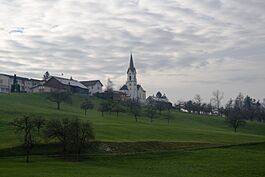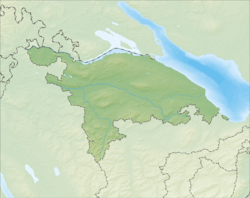Hauptwil-Gottshaus facts for kids
Quick facts for kids
Hauptwil-Gottshaus
|
||
|---|---|---|

Hauptwil-Gottshaus village and St. Pelagiberg Church
|
||
|
||
| Country | Switzerland | |
| Canton | Thurgau | |
| District | Weinfelden | |
| Area | ||
| • Total | 12.49 km2 (4.82 sq mi) | |
| Elevation | 550 m (1,800 ft) | |
| Population
(Dec 2020 )
|
||
| • Total | 2,017 | |
| • Density | 161.49/km2 (418.26/sq mi) | |
| Postal code |
9213
|
|
| Localities | Eberswil, Gottshaus, Hauptwil, St. Pelagiberg, Stocken, Trön, Wilen | |
| Surrounded by | Bischofszell, Häggenschwil (SG), Muolen (SG), Waldkirch (SG), Zihlschlacht-Sitterdorf | |
Hauptwil-Gottshaus is a cool place in Switzerland! It's a municipality (like a town or a small region) in the Thurgau canton, located in the Weinfelden District.
This municipality was formed in 1996 when two smaller places, Hauptwil and Gottshaus, joined together. In 1999, Hauptwil even won the special Wakker Prize for doing a great job protecting its old and beautiful buildings!
Contents
History of Hauptwil-Gottshaus
The area of Hauptwil-Gottshaus has a long history. Hauptwil was first written about in 1413. Gottshaus was first mentioned even earlier, in the late 1200s.
The Story of Hauptwil
By 1377, Hauptwil was part of a "fief." This was like a special land grant given by important leaders, such as the Bishop of Constance and the Abbey of St. Gall, to a family called Ryff. Later, in 1561, the land went to the Freiherr von Hallwyl family. From 1664 to 1798, the Gonzenbach family owned Hauptwil. They also had the right to make local laws and decisions, which was called "low justice."
The Catholic people in Hauptwil have always been part of the church in Bischofszell. The Gonzenbach family, who lived in Hauptwil Castle, started holding Protestant services in their castle chapel around 1667. This chapel later became a smaller church connected to the main church in Bischofszell in 1861. A new Protestant church was built in the village in 1886.
A family called Brunschweiler, who owned a big factory, helped an Evangelical Baptist movement grow in Hauptwil in the early 1800s. By 1880, about 10% of the people in Hauptwil were part of this church. Even today, there's a "free church" community there.
The Gonzenbach family made their money from the textile industry (making cloth and fabric). Because of them, Hauptwil changed from a farming village into a place with textile factories. This was good for the village because it created jobs and used the power of water from five special ponds built for the factories. In 1664, Hauptwil was allowed to hold its own market. The famous Hauptwil Castle was built in 1664-1665. Many new factory buildings and homes for workers were also built around this time.
Later, the Brunschweiler family helped the dyeing industry (coloring fabrics) grow in the village. When a railway line opened in 1876, it helped the local economy even more. Farming was still important, but it changed from growing crops to raising livestock and dairy cows. The first dairy was built in 1909.
Today, Zetag AG is the only textile factory left, as the Brunschweiler Dyeing Factory closed in 1984. In the 1970s, many new homes were built, which helped families stay in Hauptwil. The village is now known for its well-kept old buildings and its old industrial areas that have been given new life. This is why it won the Wakker Prize in 1999!
The Story of Gottshaus
The farms in Gottshaus were probably given to the Abbey of St. Pelagius in Bischofszell way back in the 800s. From the Middle Ages until 1798, Pelagi-Gottshaus was a local court area within the region of Bischofszell.
A chapel was built in Gottshaus in 1486. It was part of the Bischofszell church. In 1535, it became a special church for pilgrimages (religious journeys). In 1908, the eastern part of Gottshaus became its own Catholic community called St. Pelagiberg.
A "weir" (a small dam) was built on the river in 1430. This weir helped provide power for the textile factories in Hauptwil for many years. Since 1946, this weir has been protected by the government. Farming is still the most important activity in Gottshaus today.
Geography of Hauptwil-Gottshaus
Hauptwil-Gottshaus covers an area of about 12.49 square kilometers (4.82 sq mi). A big part of this land, about 70.6%, is used for farming. Forests cover about 18.8% of the area. The rest of the land is used for buildings, roads, rivers, and lakes.
The municipality includes the main villages of Hauptwil and Gottshaus. It also has the area around the church of St. Pelagiberg and about 40 farmhouses and small groups of homes called "hamlets."
People of Hauptwil-Gottshaus (Demographics)
Hauptwil-Gottshaus has a population of about 2,017 people. Most people (about 95.4%) speak German. Other languages spoken include Serbo-Croatian and Italian.
The population has been growing over the years. In 2009, about 11.7% of the people were children aged 0-9, and 13.8% were teenagers aged 10-19. This shows it's a place with many young families!
Most households in Hauptwil-Gottshaus are private homes, with an average of about 2.8 people living in each. Many people live in single-family homes.
Special Places and Buildings
Hauptwil-Gottshaus has some very important historical buildings! The old Tavern Zur Traube, Hauptwil Castle, and the Tortürmli (a small tower) are all listed as national heritage sites. This means they are very important to Switzerland's history and culture. The entire village of Hauptwil is also recognized as a special heritage site.
Economy of Hauptwil-Gottshaus
In Hauptwil-Gottshaus, people work in different types of jobs.
- The primary sector (like farming) employs about 184 people.
- The secondary sector (like manufacturing and factories) employs about 212 people.
- The tertiary sector (like services, shops, and offices) employs about 201 people.
Many people who live in Hauptwil-Gottshaus also travel to other towns for work. About half of the residents work outside the municipality. Most people use a private car to get to work, while some use public transportation.
Religion in Hauptwil-Gottshaus
Based on a census from 2000, about 43.7% of the people in Hauptwil-Gottshaus are Roman Catholic. About 37.6% belong to the Swiss Reformed Church (a type of Protestant church). There are also smaller groups of people who belong to other Christian churches or are Islamic. Some people do not belong to any church.
Education in Hauptwil-Gottshaus
Switzerland is known for its good education system, and Hauptwil-Gottshaus is no different. Many adults (about 73.1%) have completed higher education, like going to a university or a special college. This means people in Hauptwil-Gottshaus are well-educated!
See also
 In Spanish: Hauptwil-Gottshaus para niños
In Spanish: Hauptwil-Gottshaus para niños





